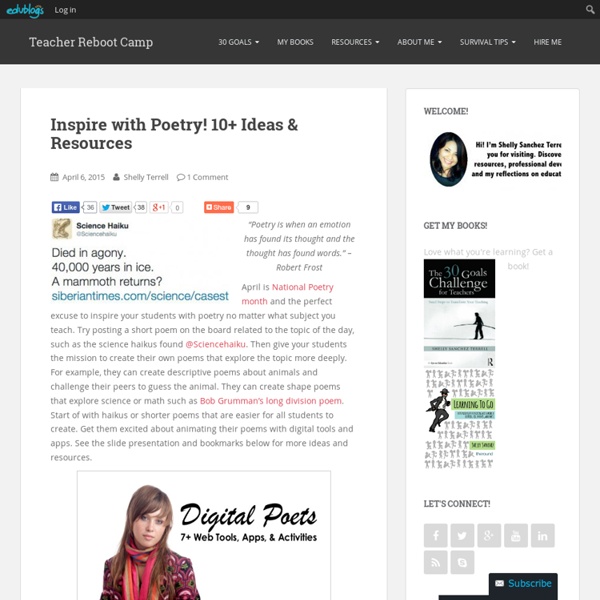



The Rapid eLearning Blog - Practical, real-world tips for e-learning success. Creating great interactive learning experiences requires a few core building blocks: relevant content, pull versus push, and real-world decisions. With those building blocks you're able to structure effective learning scenarios that are meaningful to the learner and helps meet the objectives of the course. One of those building blocks in creating relevant content or content that is placed in a meaningful context. Essentially, you want to recreate the types of scenarios that are similar to the ones the learner has in real life.
Learning Materials The Yepes webpage includes an invaluable resource tool for intermediate and advanced learners. The site includes Yepes and... see more The Yepes webpage includes an invaluable resource tool for intermediate and advanced learners. The site includes Yepes and other outstanding websites for tutorial drills, e.g. Nelson and Arana sites. In addition, the user will find grammar guide for use in writing, a writing style manual, and "Herramientas de español," an extensive outline of essential Spanish structures based on John Turner's "All the Spanish Grammar You Really Need to Know."
Sylvia Guinan, Author at Official WizIQ Teach Blog in Teaching Online, Various A Teacher For All Seasons What is a teacher for all seasons? Becoming a teacher trainer « elteachertrainer Many teacher trainers are people with extensive knowledge and experience of the subject. They have probably taught many different levels of student, different class sizes, cultures, nationalities, age ranges and students with different needs – from young learners through to adults with specific work-related requirements. Your CV or resume won’t cover every part of the ELT spectrum, but you’ll be a reasonable ‘jack of all trades’ and perhaps even a reasonable specialist in one of two of them. Longevity in ELT is often a job requirement for teacher training and most teachers who move into it have been in the profession for some considerable time. However, the first signs of wanting to train can, in fact, emerge at an early stage of a teacher’s career.
for teachers by teachers by David Dodgson “But you only teach six lessons a day and you have a guaranteed summer holiday…” Ah, the common misconception that being a teacher is somehow an “easy” job! We all know the truth, however. We know that those six hours in the classroom are intense, full hours; we know that those six hours are supported by more hours of planning and preparing; we know that those six hours are followed by marking and reviewing; and we know that those “guaranteed” weekends and holidays often include training and development. We devote ourselves to the task regardless.
Authentic Assessment Toolbox Home Page to the Authentic Assessment Toolbox, a how-to text on creating authentic tasks, rubrics, and standards for measuring and improving student learning. Inside, you will find chapters on A good place to start -- In this chapter I identify the characteristics, strengths and limitations of authentic assessment; compare and contrast it with traditional (test-based) assessment. Why has authentic assessment become more popular in recent years? When can it best serve assessment needs?
Brainfriendly learning methods, tools, environments and communities. How much can we actually teach students for exams without being exam-oriented? Wherever we go in professional development the reality of teaching to the test always crops up as something to avoid or get around somehow. Yet, we want our students to achieve high standards and we want them to have qualifications. For me, it’s a matter of teaching BEYOND the test. ********************************************************** Exposing them to real English before they ever see exam-type structures, whilst getting them used to such structures in fun, stress-free environments is a great way to raise competency well before exam deadlines loom ahead. This is a topic I wish to expand upon and develop through my blog in upcoming features.
Teaching Village Hi! I’m Barbara Hoskins Sakamoto. I’m an English teacher currently living in Kitakyushu, Japan. I’ve taught English as a Second or Foreign Language (ESL/EFL) for a little more than 20 years, and in those years I have taught all ages in many different environments–private language schools, public schools, businesses, community centers, my home, and even a university extension class or two. Why do I use three names? Well, my married name is Sakamoto, and most of my friends know me as Barb Sakamoto. Project Based Learning By Wayne D'Orio Here’s a riddle: Imagine there is a learning technique proven effective through 100 years of use that is now enhanced by the power of today’s technology. Imagine it can excite learners to continue their work well past the parameters of the school day. What is it, and would every school in the country do it?
Larry Ferlazzo’s English Website There are many pages on my main website, and they have nearly 8,000 categorized links appropriate for English Language Learners. The best place to start exploring is the Main English Page. You can read an overview about each section of my website on the Teacher’s Page. This page also has many links specifically useful to teachers. You can also go directly to each page of my website: English For Beginners and Early Intermediate eTools for Language Teachers Sketchnoting (or visual note-taking)(Click here for a presentation called "Sketchnoting for Beginners". Click here to see my sketchnotes on Flickr.) She told me that she made them with an iPad app called “Paper by fifty-three”. Well, I immediately downloaded the app and my journey into sketchnoting began. Sketchnoting is simply a way to take notes in a more visually attractive way than bullet points.